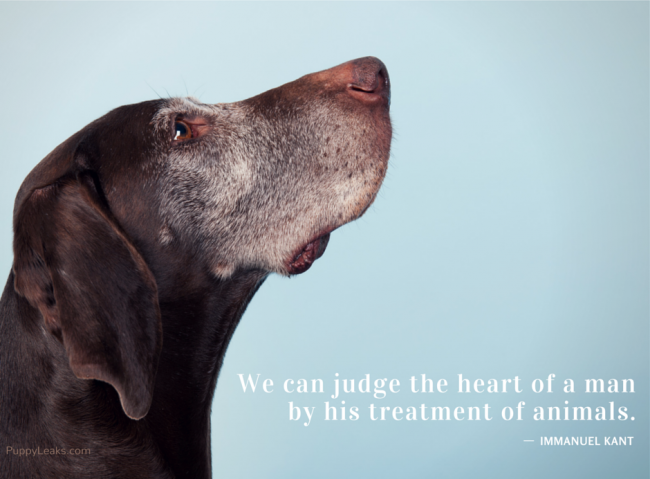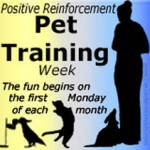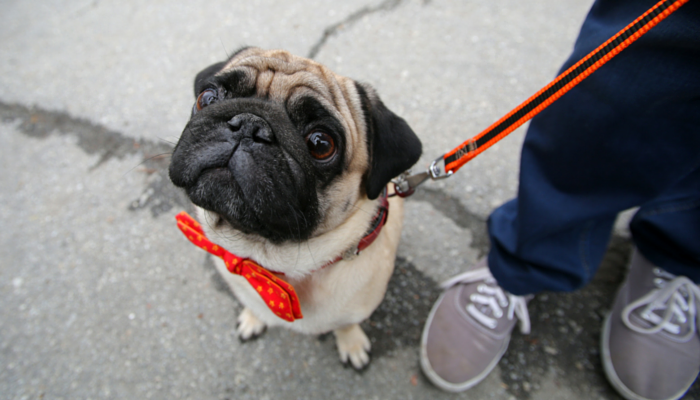Is Positive Reinforcement Training Finally The Norm?
Did you have a dog growing up? Think about how your family approached training. If yours was anything like mine (or the majority of people before the 1990’s) there was probably a lot of punishment and a lot of yelling. Yes, there was always yelling.
The Dog Books I Grew Up With Loved Punishment
I’ve always loved reading, and I’ve always had a soft spot for dogs. By the time I was 13 or so I had a stack of books about dogs. From picking the perfect family dog to training 101 – they covered it all. But you know what there was no mention of? Positive reinforcement.
The book about picking the perfect dog had some peculiar tips about addressing potential puppies. In order to find the nicest one you were supposed to alpha roll them, one by one, and see which one put up the least amount of struggle. If you alpha rolled a puppy and they fussed or growled it was a sure sign that they were dominant – aka one to be avoided.
Yes, this was the norm.
Of course these books always had a chapter on house breaking, and the advice wasn’t better at all. Did you puppy pee on the carpet? Make sure you rub their nose in it before placing them outside. They need to learn that such behaviors are not acceptable.
If you had an extra stubborn pup you might need to roll up a newspaper and smack ’em a few times too while yelling “bad, bad, bad.” That’ll teach him.

I Didn’t Know What Positive Training Was Until the 90’s
I don’t remember much at all about giving treats or rewards when puppies did anything good – it was more about controlling them by being the more dominant figure. From what I could tell this just meant you were always supposed to be louder and more aggressive than your dog, then he’ll really know whose boss.
By the late 90’s the internet was getting quite popular, and I was grateful to find some new ideas when it came to dog training. When it was time to potty train my dog Carter I had read about the importance of paying attention, not just focusing on waiting for them to make a mistake.
I’d let him out once an hour and praise like crazy when he did his duty. After a couple days he was 95% potty trained. It was as simple as that. Let the dog know what you’d like them to do by making it a celebration. Who knew?
Then came the Dog Whisperer onto TV screens everywhere who was reinforcing a lot of those older dominance theories. Although he became quite popular, I found myself disagreeing with what I was seeing him do on TV so the more exposed I became to people like Ian Dunbar and Karen Pryor.
We’re Not There Yet, But We’ve Come A Long Way
Sure, there’s still more progress to be made when it comes to animal welfare, but I believe the popularity of positive reinforcement over the past 15 years is a great start. With science behind us we no longer have to sit back and accept those old norms. We can point out that there’s more than one way to train a dog, and share our own experiences with positive training methods.
We’re all part of this push forward, whether we realize it or not. Think back to what advice you’d get 20, 15, or 10 years ago when it comes to potty training a dog. It’s changed, we’ve changed, and our dogs are no longer getting their noses rubbed in pee.
Why Did Positive Training Take So Long To Catch On?
Looking back I keep wondering – what the hell took us so long to catch on? How were we able to rub a dogs nose into the ground as they cried thinking to ourselves “Yep, this’ll teach him.”
Maybe it’s because it was the norm. Maybe it was because we overvalued punishment techniques. Maybe it was because we didn’t know any better. Whatever the reason I’m glad it’s no longer the norm. Our dogs deserve better, and luckily many of us have finally caught on.

Big thank yous to all the positive reinforcement pioneers, those that took it from the sidelines and got it out into the mainstream. Ian Dunbar, Karen Pryor, Patricia Mcconnell, Victoria Stilwell and Emily Larlham to name a few.
And to all of my fellow dog bloggers who are helping to prove how well positive training works. Thank you, and if your dogs could talk human I know they’d be giving their biggest thanks as well.
Do You Think Positive Reinforcement Training Is The Norm?
Am I being too optimistic here? From what I can tell positive training methods are everywhere – but then again we all tend to live in our own little box. Maybe there’s a lot more punishment going on that I’m aware of.
For me at least, and many of my blogging friends, positive training is the new norm, and I’m grateful.
 This post is part of the Positive Pet Training Blog Hop, hosted by Cascadian Nomads,Tenacious Little Terrier and Rubicon Days. The hop happens on the first Monday of every month, and is open for a full week – please join us in spreading the word about the rewards of positive training!
This post is part of the Positive Pet Training Blog Hop, hosted by Cascadian Nomads,Tenacious Little Terrier and Rubicon Days. The hop happens on the first Monday of every month, and is open for a full week – please join us in spreading the word about the rewards of positive training!

Great post!! I probably could of written a similar one almost word for word. That was me. I had all of the training books from the Monks of New Skete to Barbara Woodhouse… I read them and used the training methods. My dog hated me and we had a very crappy relationship. I eventually found a trainer who used clicker training and I thought it was neat but only used for training silly tricks. I did pick it up and teach my dog some tricks, though and our relationship improved. He liked me better but I will always wonder what could have been had I not used such forceful training methods on him. I sort of mourn for what I could of had.
Then Cesar Millan came on the scene and ruined everything.
Luckily, I learned immediately that his methods would not work on my new dog (Zoe). Who nearly bit me after I poked her. I went home and found a PR only training forum online and completely changed the way I worked with my dog. Then Phoenix came a long and I couldn’t touch her so I learned about capturing, shaping and working with fearful dogs.
I am so glad that PR training is more of the norm these days. I hope that more and more people will crossover!
I think positive training is the norm. Although, I was talking with a positive reinforcement trainer in my area recently. She had asked me how I would go about encouraging someone to try positive reinforcement techniques vs. other options and I told her that’s easy because I feel like most people WANT to use positive reinforcement. They just might not know how. She actually said she felt the opposite. She gets frustrated because she thinks so many people still aren’t interested in using positive reinforcement training.
Interesting on the older books you mentioned. I definitely read a few similar ones. And get this, my dad has this gun dog training book from the 60s. I was looking through it out of curiosity. It’s an OK book but it literally says in there several times, “Sometimes you just have to take the dog behind the woodshed.”
Boy, times have changed!
I think it still has some ways to go to become norm but most reasonable people subscribe to it. Which is good.
I love this post. I was just like you. I even trained a search and rescue dog in the early 90’s. There was a sprinkling of positive training in the mix but the basic behavioral stuff was all based on corrections.
For me, when I first learned about positive training, I didn’t understand how positive training could prevent bad behaviors. I still get stumped by this issue sometimes but some creative thinking (or reading stuff by experts) usually helps me use positive techniques for these types of problems. I wonder if that isn’t a big hurdle for many people if they hear about positive training.
I’m sorry to say that I think that we live in a bubble. My home is in a rural part of Colorado in the mountains. 99% of my neighbors either use correction-based training (including shock collars) or don’t train their dogs at all. In contrast, in my community of internet friends and in my trainer’s classes in a city near here, it feels like positive training is winning. So, I guess it’s still a toss up, in my view.
What a wonderful post and I thank you for all your articles that have helped spread awareness about positive training methods too.
My dad was our primary dog trainer while growing up and he used the older, discipline methods too. They worked for the most part, but it wasn’t a positive learning atmosphere for the dogs. Even today I have “discussions” with him about why you shouldn’t yell at a dog for not coming to you right away. Luckily, my mom gets it and she’s helping him to get onto the positive side of training.
Sadly, I do think that punishment is still the norm. But you’re right, the positive reinforcement movement is really picking up steam.You have to look to find a trainer that uses punishment as a teaching technique these days but the ones that use positive reinforcement are everywhere.
I believe that the younger generations have embraced it but the older ones are still set in their ways for the most part.
I misread your first subhead and thought it said the dogs you grew up with loved punishment!!
That alpha roll thing to temperament test puppies. So weird. And rubbing a dog’s nose in their poop? Ugh.
I think positive reinforcement is big in our bloggy world where we care enough about our animals to learn and grow by reading. But I don’t yet think it’s wholesale accepted or understood in the wider world.
Routinely on walks I see people doing “dog whisperer” techniques.
The good news is that the more extreme techniques (like hanging a dog from his leash) are mostly gone from the mainstream. And a happy, well-adjusted dog won’t suffer too much because his person eats before feeding him.
Honey’s breeders are very nice people who know a lot about golden retrievers. But they still believe some of that dominance crap. They advised us to roll Honey onto her back to show her we were boss. They did it with their puppies. But their version of an alpha roll was to gently cuddle the puppy on his back and tickle his belly.
Their training philosophy was bad. But they are gentle people with gentle dogs so they adapt the training to make it more mild than it would be in other hands.
It’s still not as popular as I would like, and sometimes I am surprised by the number of people who use e-collars in more general circles, but I think it’s getting there, which makes me so very happy.
Ok so the methods of training dogs for the last 10,000 years are all wrong and NOW we have a better method?
Yes, I totally agree that you have to catch a dog in the act to match the discpline. But if you catch the dog peeing and stick his nose in it and wack his bum, that is instant training. Now having raised dogs for 40 years, now my wife want to use the new method of praising him when he pees outside. So for MONTHS we are traking our dog outside to pee every 30 mins and often he comes in right after and pees right infront of us. Yes 100 accidents later we are wrecking our flooring!!! But Now I have have to live with Todays Method are Better!! .. Well we sure never had but a few accidents for my two generations of raising many dogs and two wacks in the butt to train a dog does NOT damage a dog for life.. My God people get serious!
I had really good luck with taking my last 3 pups outside & praising like crazy when they went to the bathroom. They caught on quickly that going outside is what’s desired, and that’s what gets them all the extra petting & treats.
I wouldn’t be promoting positive training if it hadn’t worked for me, but as with any form of training your results may vary depending on the specific dog. And I don’t like to think we’ve been “wrong” for 10,000 years as far as training goes, we were all just doing what was the norm of the time, and punishment and fear based methods can lead dogs to behave differently. But now that we’re learning more about our dogs & their cognitive abilities we’re adapting our methods to match what the science says about their ability to learn, and starting to understand that punishment isn’t the best form of motivation.
It does. This is a scientific fact. It is well established in the behavioural science literature. If you want to make positive reinforcement training even more powerful, use a clicker. A clicker is used to facilitate communication and precision in training, and is helpful when teaching complex behaviours. https://bit.ly/best-dog-trainers